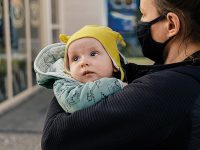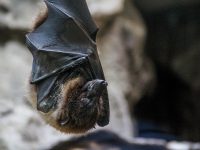Tsunamis, waves, Quixotes, and KO-vid
Metaphors about the pandemic as seen in cartoons
Several studies have shown evidence for the significant role that metaphors play in public health communication. The arrival of the COVID-19 pandemic has triggered not only the use of common communication frameworks such as war metaphors, but also the creative use of metaphors, which is particularly relevant in the case of cartoonists. This article presents a review of the different metaphors used in cartoons (both in Spanish and in English), with the aim of compiling different metaphorical uses and reflecting upon the evaluative function of metaphors and how they contribute to expressing different visions of reality. The examples collected here show not only how certain social and political actions are legitimised or discredited, but also how these uses often appeal to particular contextual knowledge.
Keywords: metaphor, COVID-19, cartoons, discourse analysis, construals.
What are metaphors and why do we use them?
Throughout the COVID-19 pandemic, it has been common to find different language uses emerge in the media to describe and explain this hitherto unknown disease. The appearance of expressions such as «fighting the virus», «de-escalation», «maintaining a social distance», or «hibernating the economy» is the result of the use of metaphors. These are defined as cognitive mechanisms that allow reality to be understood and explained by establishing mappings between two conceptual domains (Lakoff & Johnson, 1980). Metaphors are like photographs of reality because the similarities they draw upon can be interpreted in different ways by people who see or hear them and because they show us not only the world, but also the specific framing and stance of the speaker or photographer. Metaphors, therefore, are easily manipulated and not only have an explanatory value, but also carry a clear ideological charge.
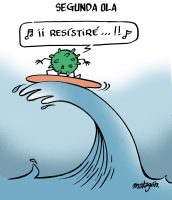
The cartoons considered in this text show a wide metaphorical creativity. This is illustrated by the use of images such as waves, tsunamis, birds, or anthropomorphic viruses. The image on the left shows a cartoon by Malagón, published in the newspaper 20 minutos on 28 July 2020.
We can see how a metaphor works, for example, in the description of the pandemic by public officials such as the President of the Spanish Government, who described it as a «war against a criminal enemy who is taking lives» (Sánchez, 2020). In this statement, the word war activates a cognitive framework based on violence and opposition between two fundamental participants: the virus – characterised as the enemy to be beaten – and the society fighting against it. This conceptualisation of society as soldiers or as an army can be re-elaborated according to different communication needs in order to place greater emphasis on (or foreground) health workers. These workers are seen as the army fighting the virus – «all work[ing] together to win the war against the virus with our over 350,000 National Health System professionals» (Sánchez, 2020). In another example, society as a whole takes this role: «in this irregular and strange war in which we are forced to live or fight, we are all soldiers» (Villarroya, 2020).
The similarities established between war and the COVID-19 pandemic are not accidental, and they generate subjective conceptual frames that outline certain components (Semino, 2008). For example, the opposition between the enemy (the virus) and those fighting against it (society or essential workers), the means (cleanliness and physical distance) to participate in the battle (or lack of those), as well as individual responsibility and the dangerous nature of the virus (and, by extension, its carriers). Reflection upon the use of the war frame in academia, led by the collaborative initiative #ReframeCovid (Olza, 2020), and in the media (Garrido Díaz, 2020; Tisdall, 2020) shows that the use of metaphors is not harmless and has clear ideological and emotional effects (Flusberg et al., 2018).
Explaining the pandemic: Metaphors and cartoons
Based on the value of metaphors as a conceptual organisation mechanism, we can point out that different aspects of a metaphor can be emphasised depending on the communicative needs at each moment. While the discursive treatment of COVID-19 could focus on several elements (Filardo-Llamas, 2020a; 2020b), one of the most relevant aspects is the use of metaphors to discursively construct and evaluate the actions of social and political participants. Among these participants we find not only the characterisation of the virus (what it is and how it is spread), but also a description of the different social groups facing the disease, both as carriers of the virus and as those trying to eradicate it, and of the different political actors who decide how to manage the pandemic.
«Metaphors work as a photograph of reality, showing the specific framing and stance of the speaker»
While criticism of the use of war terminology has mainly been related to the way political stakeholders have explained the pandemic to society, several of the most creative uses of alternative metaphors collected in the collaborative database #ReframeCovid come from other sources. Most notably cartoons, which can be understood as the visual and often humorous response to current events. Through the use of humour, these cartoons show the reality of the virus and assess the political management of the pandemic. Various studies related to metaphorical uses in cartoons have explored this capacity for evaluation (Domínguez, 2014; 2015), which is influenced not only by the author’s stance but also by knowledge shared between the author and the audience. Many of these illustrations are accessible in large databases available on the Internet or in printed information and opinion publications. Cartoons are also interesting from a communicative point of view because of their multimodal nature, since metaphors are evoked not only through words but also through the relationship between words and images (Forceville, 2020; Forceville & Urios-Aparicio, 2009).
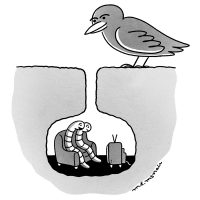
Figure 1. In Elizabeth McNair’s cartoon, published in The New Yorker on 11 May 2020, the virus is conceptualised as a bird of prey ready to eat some worms as soon as they leave the house.
In this study, in order to collect examples that would allow us to explain different metaphorical uses, various sources were used. For examples in English, we conducted a search mainly in the Politicalcartoons.com and Cagle.com databases. These searches were based on two parameters: COVID-19 and the metaphorical frames already present in the #ReframeCovid collection (Olza, 2020), from which we also retrieved some examples. To those results, we also added illustrations from The New Yorker – mainly because our informal observations had shown that the cartoonists in this publication often creatively activated metaphorical frames. Additionally, we also used examples from the China Daily in an attempt to collect cartoons that were not produced in the Western context. For Spanish items, cartoons published in El Diario, ABC, and El Mundo were mainly studied. Finally, the searches were complemented with some references obtained in the Google image search engine, using the keyword combination «COVID-19 + specific metaphorical frames».
Metaphors and politics, polarising the pandemic
Although the military framework has permeated part of the public communication about the pandemic, both in the political sphere (Ceccarelli, 2020) and in some social networks (Wicke & Bolognesi, 2020), a rich metaphorical creativity was also observed in political cartoons describing the virus, as well as in reference to the progress of the pandemic and to the different social actors linked to it.
A frequent use of metaphors in cartoons consisted of making the virus visible by showing it as a person, an animal, a force of nature, or even a monster or an alien (Llopis-García, 2020b). This emphasises its presence and threat, while at the same time criticising different social behaviours and (de)legitimising certain political decisions. As an example, we would like to draw attention to the conceptualisation of the virus as a bird of prey, ready to eat some worms as soon as they leave the house (Elizabeth McNair, The New Yorker, 11/05/2020; Figure 1), accompanied by a comment by one of the worms: «Hey! The experts are saying it’s safe to go out again.» By rendering an invisible virus visible, both the picture and the text point out that the virus is still dangerous and implicitly criticise the end of lockdown measures. In the Spanish context, it is common for the virus to be personalised and shown in a dialogue with other viruses, celebrating the ability to spread thanks to certain behaviours such as demonstrations and the citizen protests in May against the management of the pandemic (Martí, 2020).
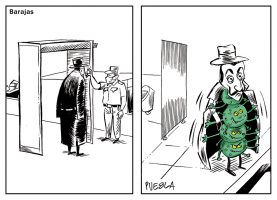
Figure 2. A frequent use of metaphors in cartoons consists of making the virus visible by showing it as a person, an animal, a force of nature, or even a monster or an alien. This emphasises its presence and threat. Above, a cartoon by Puebla titled «Barajas. Everything under control», published in the newspaper ABC on 13 July 2020.
Metaphors are not only part of the narrative structure of these cartoons. Their interpretation is also determined by the context, as seen for example, in the cartoon published by Puebla in ABC, showing a virus disguised as a person freely walking through an airport security checkpoint (Figure 2). The text of this cartoon serves a double function: on the one hand, it establishes a contextual anchorage point through the use of the word Barajas (the name of the largest airport in the country), and also provides information about the author’s criticism of the decision to re-open Spanish borders. On the other hand, the multimodal interaction between the metaphorical representation of the virus as a person and the text of the cartoon – «everything under control» – reminds us both of the airport «control checkpoint» and the response of the authorities to the potential spread of the virus in these spaces. Thanks to the polysemy of this word, it also functions as a stimulus to activate the cognitive assessment and emotions of readers. This means that the text can be understood as ironic because the virus is entering the country and so nothing is under control, thus emphasising the criticism of political decisions.
Examples can be also found where the nature frame is evoked to delegitimise political actions. This is the case of one of Graeme MacKay’s cartoons criticising the inactivity of a government that asks its citizens to wash their hands and keep their distance but fails to notice the arrival of two tsunamis, one called COVID-19 and another called recession, heading towards a city where the Canadian flag is flying (The Hamilton Spectator, 11/03/2020). This cartoon has been adapted to different contexts including France, Israel, and the United Kingdom, showing not only the ubiquity of the metaphor – at least in the Western context – but also that its interpretation depends on the context in which it is produced and the co-textual signs (the changing flag in this case) that allow it to be interpreted.
«The word war activates a cognitive framework based on violence and opposition between two fundamental participants: the virus and the society fighting against it»
Although references to waves and tsunamis are common to describe Donald Trump’s political activity (Daryl Cagle, 28/03/2020; John Cuneo, The New Yorker, 8/07/2020), the analogy between the coronavirus and a volcano found in a cartoon by Drew Sheneman is particularly interesting (Tribune, 29/03/2020). It shows Donald Trump pushing an old woman into the crater of an erupting volcano. Trump is aware of the danger the volcano represents, but thanks the woman for her «sacrifice», hoping it will help «restart the economy». The metaphorical narrative sequence of this cartoon rejects Trump’s actions – as we understand that it is his responsibility to care for the American nation –; while also delegitimising the subordination of social welfare to the country’s economy, the latter being presented as the justification for his actions.
Similar criticisms of political management could be observed in Spain, where the pandemic was metaphorically described as a game of chess (Figure 3) in which the health workers and essential workers are the pawns, sacrificed so that the rest of the pieces (politicians, the army, and the European Union) could survive (Manel Fontdevila, El Diario, 10/04/2020).
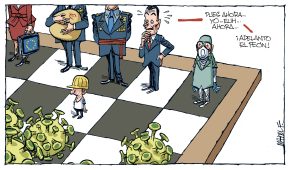
Figure 3. Criticisms of political management can be observed in the metaphorical description of the pandemic as a game of chess in which health workers and essential workers are the pawns, sacrificed so that the rest of the pieces (politicians, the army, and the European Union) can survive. Cartoon by Manel Fontdevila published in El Diario on 10 April 2020.
The metaphorical conceptualisation of the virus in the political arena has been used to criticise both the management of the pandemic and the growing political polarisation in different geographical areas. In Spain, examples include the visual depiction of the virus as an animal in a slaughterhouse, where two butchers who physically resemble the leader of the far-right Vox party (Santiago Abascal) and the president of Partido Popular (Pablo Casado) are preparing to butcher the animal to «make good use of everything». The different parts of the animal-virus contain references to the arguments used in the political debate about the management of the pandemic, with words like «asesinos» (“murderers”), «la paguita» (“a pay-off”), «fascistas» (“fascists”), or «dictatoriales» (“dictatorial”), among others (Manel Fontdevilla, El Diario, 20/04/2020). These words reproduce some of the arguments used by the two politicians to criticise other parties and refer to some measures taken by the government such as the introduction of the guaranteed minimum income, a benefit aimed at preventing poverty and social exclusion in the context of the pandemic, which Abascal disparagingly described as «la paguita». In this context, the concept of making good use of the situation evaluates and delegitimises the political activity of these two right-wing parties.
«Through the use of humour, these cartoons show the reality of the virus and assess the political management of the pandemic»
This same kind of delegitimization underlies the processes of metaphoric inversion, or reversal between the two domains that generate a metaphor (Deane, 1993). This process implies that the virus is used as a metaphor to describe the political activity during the pandemic. Some instances compare Donald Trump and the coronavirus (Dave Whamond, CagleCartoons.com, 24/05/2020; Kevin Siers, The Charlotte Observer, 22/06/2020; Manel Fontdevila, El Diario, 26/07/2020) and consequently, the impact and effect his decisions have on the virus. Similarly, based on the schematic representation of the coronavirus as a round, spiked entity, these spikes are visually reconfigured to refer to political accusation (Luo Jie, China Daily, 10/04/2020) or to the various decisions taken during the pandemic, such as lockdowns, openings, lockdowns, and re-openings (Paresh, China Daily, 27/07/2020). Based on the negative evaluation of the virus, we see that these features are transferred to the political activity by means of a conceptual combination of metaphors (politics as a virus) and metonymies (political decisions as the coronavirus spikes), thus delegitimising not only the adversarial nature of the political game but also the constant changes and indecision in the political management of the pandemic.
Metaphor and society: Recognising essential work
The identification of opposing participants in different re-elaborations of the same metaphor allows us to understand how each of them evaluate the situation, as they are based on shared knowledge. Thus, if the opposition mentioned above occurs between politicians and society in a game of chess, it discredits political management. However when healthcare workers are shown arm wrestling the coronavirus – once again anthropomorphising the virus – the metaphor takes on a positive value, legitimising and applauding the individual and collective actions of the healthcare workers who are trying to put an end to the virus (Miki & Duarte, Diario de Sevilla, 12/03/2020). Another metaphorical use emphasising the recognition of essential workers (Llopis-García, 2020a), especially healthcare workers, was their depiction as angels (Angel Boligan, El Universal, 13/05/2020) or superheroes (Javi Salado, 24/03/202; Jeff Koterba, CagleCartoons.com, 26/03/2020; Dave Whamond, CagleCartoons.com, 26/03/2020; Miki & Duarte, Diario de Sevilla, 28/03/2020) (Figure 4).
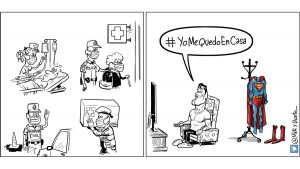
Figure 4. Other metaphorical uses were found that emphasised the recognition of essential workers, especially healthcare workers, as angels or superheroes. Above, a cartoon by Miki and Duarte, published in Diario de Sevilla on 28 March 2020.
Particularly interesting are metaphorical uses combined with intertextual references, which emphasise the value of shared and contextual knowledge in the interpretation of the metaphor. As an example, we can find healthcare workers conceptualised as “Quixotes” in the Spanish context (Idígoras & Pachi, El Mundo, 14/03/2020; Puebla, ABC, 29/07/2020), or references to boxing in North America. This last example illustrates both the importance and the multimodal nature of intertextuality. In Angel Boligan’s cartoon (El Universal, 25/05/2020) entitled «KOvid19», we see a researcher portrayed as a boxer wearing a mask, supported by the ropes of the ring, and wearing boxing gloves while he looks through a microscope. This characterisation helps to metaphorically compare boxers with healthcare workers or scientists. Furthermore, the adaptation of the virus name by placing «KO» in capital letters also activates the boxing framework and depicts healthcare workers and their actions – or scientists and the much sought-after vaccine – as the desired winners of the fight.
Summary
COVID-19 came into our lives in March 2020 and we found ourselves in a situation that was difficult for citizens to understand and also complicated to explain within public discourse. Among other changes in language usage, linguists have detected a growing use of metaphors to explain a so-far unknown reality (Lawson, 2020). The analysis of the cartoons considered in this text shows a wide variety of metaphorical creativity, illustrated by the use of images such as waves, tsunamis, birds, or anthropomorphic viruses, and shows the role of metaphors as a mechanism to evaluate reality.
«Metaphors are easily manipulated and not only have an explanatory value, but also carry a clear ideological charge»
Thus, we can see that different metaphorical uses outline different aspects of the situation and activate different emotions. For example, the characterisation of healthcare workers as angels, superheroes, or boxers helps to legitimise the work of this group during the pandemic. In contrast, virus references when discussing political activity, the personalisation of the virus itself, or the activation of nature-related frameworks have been used to criticise political decisions, as well as the problems encountered in the management of the pandemic. These examples allow us to understand the mobilising power of metaphors and contribute to deepening the much needed critical reflection upon the processes of public communication and their adaptability to different contexts.
References
Ceccarelli, L. (2020). COVID-19: Las metáforas de la pandemia. Métode, 105, 9. https://metode.es/revistas-metode/opinio-revistes/especial-covid-19-es/covid-19-las-metaforas-de-la-pandemia.html
Deane, P. D. (1993). On metaphoric inversion. Metaphor and Symbolic Activity, 8(2), 111–126. https://doi.org/10.1207/s15327868ms0802_3
Domínguez, M. (2014). Einstein versus neutrinos: The two cultures revisited with the media coverage of a scientific news item in cartoons. Science Communication, 36(2), 248–259. https://doi.org/10.1177/1075547012472685
Domínguez, M. (2015). On the origin of metaphors. Metaphor and Symbol, 30, 240–255. https://doi.org/10.1080/10926488.2015.1049858
Filardo-Llamas, L. (2020a, June 4). Metáforas del coronavirus. [Video]. YouTube. https://www.youtube.com/watch?v=ANPTgkfFR28
Filardo-Llamas, L. (2020b, September 15). No es lo mismo estar en guerra que remar juntos: La importancia de las metáforas sobre COVID-19. The Conversation. Retrieved September 16, 2020, from https://theconversation.com/no-es-lo-mismo-estar-en-guerra-que-remar-juntos-la-importancia-de-las-metaforas-sobre-covid-19-144337
Flusberg, S. J., Matlock, T., & Thibodeau, P. H. (2018). War metaphors in public discourse. Metaphor and Symbol, 33(1), 1–18. https://doi.org/10.1080/10926488.2018.1407992
Forceville, Ch. (2020). Visual and multimodal communication. Applying the relevance principle. Cambridge University Press.
Forceville, Ch., & Urios-Aparicio, E. (Eds). (2009). Multimodal metaphor. Mouton de Gruyter.
Garrido Díaz, S. (2020, April 1). Esto no es una guerra y la metáfora ya no vale. El Diario. Retrieved September 12, 2020, from https://www.eldiario.es/opinionsocios/guerra-metafora-vale_132_1218166.html
Lakoff, G., & Johnson, M. (1980). Metaphors we live by. Chicago University Press.
Lawson, R. (2020, April 28). Coronavirus has led to an explosion of new words and phrases – and that helps us cope. The Conversation. Retrieved September 12, 2020, from https://theconversation.com/coronavirus-has-led-to-an-explosion-of-new-words-and-phrases-and-that-helps-us-cope-136909
Llopis-García, R. (2020a, May 21). #ReframeCovid - Más abrazos y menos guerra. https://reyesllopisgarcia.com/blog/2020/5/21/reframecovid-mas-abrazos-menos-guerra
Llopis-García, R. (2020b, June 2). #ReframeCovid - Monsters and machines in the time of corona. https://reyesllopisgarcia.com/blog/2020/6/2/reframecovid-monsters-and-machines
Martí, F. (2020, October 5). Radar covid. Humor fresco del día. https://ferranhumor.wordpress.com/
Olza, I. (2020). #ReframeCovid. Retrieved September 9, 2020, from https://sites.google.com/view/reframecovid/home?authuser=0
Sánchez, P. (2020, March 28). El presidente del Gobierno anuncia la suspensión de las actividades no esenciales. La Moncloa. https://www.lamoncloa.gob.es/presidente/actividades/Paginas/2020/28032020_noesenciales.aspx
Semino, E. (2008). Metaphor in discourse. Cambridge University Press.
Tisdall, S. (2020, March 21). Lay off those war metaphors, world leaders. You could be the next casualty. The Guardian. https://www.theguardian.com/commentisfree/2020/mar/21/donald-trump-boris-johnson-coronavirus
Villarroya, M. A. (2020, March 20). Rueda de prensa posterior a la reunión del Comité de Gestión Técnica del Coronavirus. La Moncloa. https://www.lamoncloa.gob.es/multimedia/galeriasfotograficas/covid19/Paginas/200320-tecnicos-coronavir.aspx
Wicke, P., & Bolognesi, M. (2020). Framing COVID-19: How we conceptualize and discuss the pandemic on Twitter. ArXiv. https://arxiv.org/abs/2004.06986
Acknowledgements
This text is part of the projects CODISCO (FFI2017-85227-R), funded by MINECO, and STANCEDISC (PGC2018-095798-B-I00), funded by the Spanish State Research Agency.

